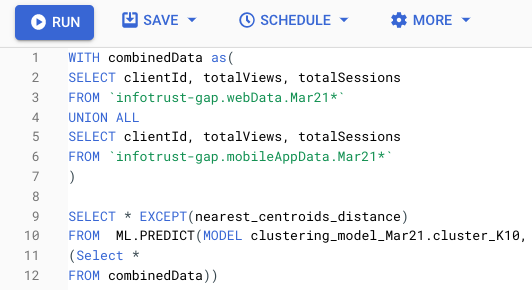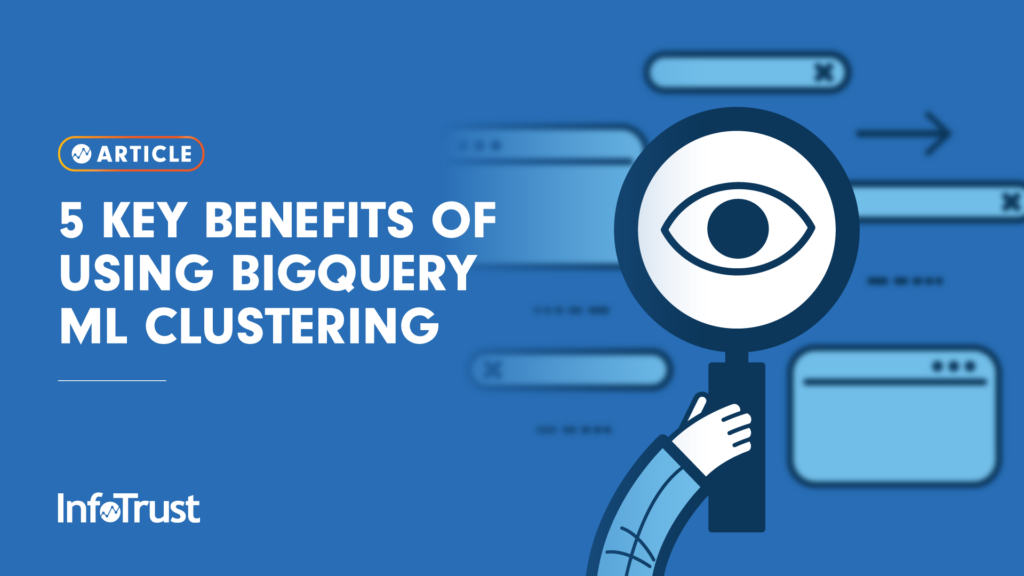With the increase in U.S. data privacy laws and a cookieless world on the horizon, augmenting marketing strategies with first-party data is more important than ever. As a digital marketer, this may cause you the challenge of determining how to use first-party data to understand customer behavior and to create personas based on customer attributes. What’s important to note is that using first-party data through your owned digital channels means that you are using data users have consented for you to use—therefore it’s reliable and insightful. Using first-party data also creates trust with your users, as well as expectations on receiving more personalized experiences.
Building a first-party data strategy is critical to the future of your business and one of the key ways you can leverage it is by building customer profiles through the use of BigQuery Machine Learning (BQML) clustering model. Segmenting customers this way helps incorporate additional customer knowledge into activating marketing strategies and creating marketing campaigns. For eCommerce businesses, smart segmentation can also help determine the most valuable and profitable customers which enables cross-selling, upselling, and repeat purchases. A BQML clustering model using k-means clustering makes it easier to segment customers and build personas. For example, an eCommerce business can use the model to do an RFM analysis where you understand Recency (when your customers last made a purchase); Frequency (how often your customers make purchases); and, Monetary (how much your customers spend). Another option businesses can take is to segment customers by Customer Lifetime Value (CLV) or CLV by acquisition channels.
Below I’ll be providing the key benefits of using the BigQuery ML clustering model. Every digital marketer should know and consider these benefits when looking to advance from using traditional Google Analytics advanced segments.
But First … What Are Clustering Algorithms?
Clustering algorithms compile customer data and group together customers with similar behavior. In the era of customer personalization, clustering algorithms can help you build customer personas so that they can design campaigns and send specialized messages that appeal to customers in each persona.
[Read more: Creating a k-means clustering model is a great resource about using the BigQuery ML k-means algorithm to group data.]
Benefits of Using BigQuery ML Clustering Algorithm to Build Customer Personas
1. Ease of Storing Data from Various Platforms
By leveraging native integrations within the Google Cloud and Google Marketing Platform, YouTube, and Google Ads, the process of loading customer data to BigQuery is seamless. Since BigQuery is a data warehouse, it can also store other non-Google data sources such as CRM data.
2. Scalability to Run on Large Data Sets
BigQuery ML provides users with the ability to explore, develop, and run clustering algorithms on large data sets within a few minutes. This allows you to bring in vast amounts of customer attributes that are relevant for creating personas for customers in each cluster. It also provides the ability to run models over live datasets, making it possible to create automation pipelines for companies to continue to load new customer data for clustering and analysis.
3. Relatively Simple to Implement
Running the clustering model on BigQuery ML is as simple as:
- Adding “CREATE MODEL” statement to a “SELECT” query
- Defining the number of clusters you’d like to run in “num_clusters”
- Adding the attributes you’d like to cluster on; in this example, we built a simple model to group users based on website and app engagement as measured by frequency and depth
- Below is an example:

By using the ML. Predict function, you can bring in the necessary attributes from your dataset to examine the clusters and understand the primary customer attributes for each of the clusters.

4. Fast, Robust, and Easy to Understand
BigQuery ML is a capability inside BigQuery; therefore, model creation and running the model is done within the BigQuery console. All data is stored in BigQuery, so this decreases the time to build the dataset to use for the model and analysis. Using the BigQuery ML clustering model for clustering data means that you can leverage the pre-built clustering algorithm by writing simple lines of code. You do not need to transfer data to a different environment for modeling, such as Virtual Machines. Lastly, BigQuery ML provides common evaluation metrics that can help evaluate how good the model is, as well as help interpret the different clusters it has generated.
5. Enabling Data-Driven Decision-Making
By clustering large amounts of customer data, you will be able to uncover patterns and anomalies that you wouldn’t otherwise find using Google Analytics advanced segments, for example. With the unique customer segments created by the clustering model, you can discover the user’s behavior and preferences which can help with building the personas. The clusters can also be passed to Google Analytics through a custom dimension by using the data import feature. This helps in both the creation of segments for analyzing user behavior and creation of audiences for retargeting. With using first-party data, you can build more accurate customer profiles, generate meaningful insights, find new ways to optimize digital platform content, and personalize campaigns messages in order to encourage the customer to visit or convert.
[Read more: How a Major Health Care System Utilized Google BigQuery to Create Automated Reporting Dashboards]
With the five key benefits in mind, companies can use BigQuery ML clustering to understand the audiences that are visiting their platforms, and to create segments for effective campaign messaging. By leveraging first-party data in the BQML model, you will create a durable approach for the long-term as it will enable reproducibility of the process and be future-proof for upcoming changes in privacy laws. Overall, BQML clustering provides many opportunities to use customer segmentation to drive personalization and provide the opportunity for your brand to nurture your relationship with customers along the customer journey.



